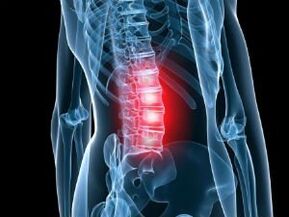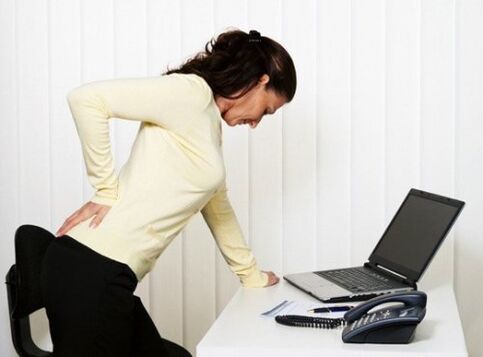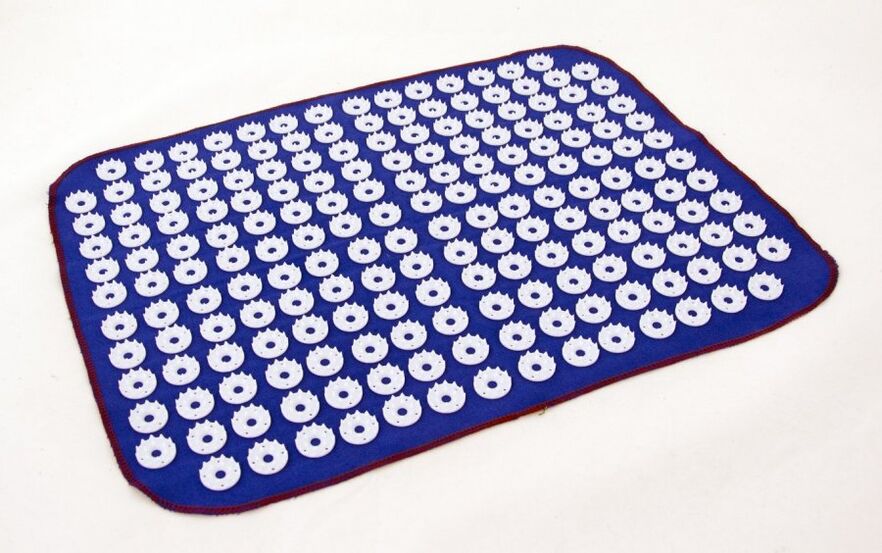
According to medical statistics, the pain in the back of 80% of cases is caused by lumbar osteochondrosis.As a result, this happens as a result of degenerative-dystrophic changes in this segment when the intervertebral windows and the adjacent vertebrae are affected.Osteochondrosis of the lumbar spine (SPEP) manifests itself through different symptoms: pain of different nature, limitation of mobility, impairment of the sensitivity of the lower body, etc. With a long absence of treatment, degenerative processes apply to vertebrae and reduce the work capacity, then the patient can become a disability.
In order to avoid dangerous complications of lumbar osteochondrosis (PO), you must start comprehensive treatment in 1-2 phases of the pathology.In advanced cases, surgery is carried out if there are already irreversible changes in the hard drive or vertebrae.In order to avoid osteochondrosis of the lower back and related complications, it is necessary to carry out its prevention.
The development of lumbar osteochondrosis
In order to understand what osteochondrosis of pop (lumbar spine) is, you need to examine the structure of the spine.It consists of the vertebrae between which cartilage seals (intermediate disc) are placed.The disc is covered with a hard fiber membrane (fiber ring), in the pulpoose edge of which is a pulpoose.This structure carries out a shock -absorbing function and makes the spine more flexible.
Reference.The lumbar segment of the spine is exposed to a large load daily because it withstands the weight of the upper body.Therefore, the osteochondrosis of the lower spine is diagnosed more often than cervical breast.
With regular loads on the spine, the slices are compressed, many liquids are lost, their height is reduced and the distance between the vertebrae decreases.The cartilaginous poetry becomes fragile, microrises occur on its surface, which leads to the pulpoose nucleus over time.With the further compression of the intervertebral discs, the outer membrane and the loss of the gallery -like body occur, the hernia form.Then the pathological mobility of the vertebrae occurs, the load on the neighboring segments of the spine increases.
A little later, bone growth (osteophytes) begin to form on the edges of the vertebral bodies.So the body tries to stabilize the spine.
Doctors distinguish 4 stages of the osteochondrosis of the lumbar spine:
- 1 degree - problems with slices begin, the central part is dehydrated, it is flattened, cracks appear on the outer shell.It stuck.
- 2 degrees - cartilage seals, the vertebrae approach each other, become mobile, muscles and ligaments around the spine sac.Pain appears.
- 3 degrees - lead, hernia, subluxation of the vertebrae are formed.The pain is reinforced, mobility limited, the sensitivity of the lower body is affected.
- Osteochondrosis of the 4th degree is characterized by the appearance of osteophytes, which the spinal nerves, neighboring vertebrae, can damage.There is constant pain, pronounced neurological disorders and other complications that increase the risk of disability.
It is easiest to heal the lumbar chondrosis (stage 1), but it is very difficult to recognize the disease at this stage.The intervertebral osteochondrosis of the 2nd degree is treated using conservative methods.Operation may be required in 3-4 stadiums.
Reference.According to statistics, the SPP is found more often in patients after 30 years.After 20 years there are often cases of pathology in humans.About 80% of the patients of 60 years suffer from the manifestations of this disease.
Reasons
In order to understand how to deal with osteochondrosis from Pop (lumbosacral vertebrae), you have to know his reasons:
- Regular static or dynamic stress in the lumbar segment.The risk group for the development of osteochondrosis includes office workers, professional athletes (heavy athletics), makers, builders, etc.
- Violation of attitude, longer stay in the wrong pose.
- Genetic predisposition, anomalies of the formation of vertebral bodies.This category includes youthful software - curvature of the spine, which is caused by pathologies of the vertebral body.
- Injuries to the spine.
- Hormonal imbalance, metabolic disorders, endocrine diseases that disturb the metabolism in the lumbar segment.
- Age -related changes in the body provoke the wear of the windows.
- Bone -tuberculosis, osteomyelitis (astrite inflammation of the bone tissue), ankylosinus spondylitis (inflammation of the vertebrae and joints), rheumatoid arthritis, etc.
The disease often causes several reasons at the same time.
There are also factors that cause the development of lumbar osteochondrosis:
- Excess body weight.
- Passive lifestyle, longer seat.
- Regular use of harmful foods (fat, fried foods, confectionery, semi -financed products, etc.).
- Lack of liquid, dehydration.
- Congenital disorders of the structure of the spine, for example an additional vertebrae.
- Unpleasant heels regularly wear.
- The period of the fetus, then the load rises on the spine.
- A sharp task of training profile athletes or excessive sports in people who were previously passive.
- Smoking, more frequent and moderated alcohol consumption.
There are many other factors that can bring degenerative-dystrophic processes in the lumbar spine on the market.For example, flat feet, frequent hypothermia, frequent stress, sleep disorders, etc.

Symptoms
The symptoms of osteochondrosis of the lumbar spine are diverse, they depend on the stage of pathology and the localization of the affected area.
Doctors distinguish reflex and compression syndromes (a complex of symptoms) for SPP.The former occurs with irritation of the receptors of the outer membrane of the panes, ligaments, joint capsules and the latter - when nerve bundle, blood vessels, spinal cord are compressed.
There are such reflex syndromes of lumbar osteochondrosis:
- Lumbago.Fire the pain on the bottom of the back with a sharp movement or tension.When trying to move, pain syndrome is improved so that the patient freezes in a pose.The muscles in the damaged area are strongly tense and painful sensations are more pronounced.These manifestations are connected to the movement of the pulpoose nucleus within the outer shell.
- Lumbargia.A real pain develops for several hours or days.Discomfort intensifies with movements, a change in the body position.It is weakened when a person takes a horizontal pose with a roller under the lower back.When lifting a straight leg in this position, the pain increases (Lassa symptom).The degree of muscle tension is less than with the lumbar.The mobility of the lower back is limited.
- Sciatica.Painful sensations (acute or painful) spread from the lower back to the lower body.These characteristics are increased during the movements.The pain is weakened when you rest on your back.The muscles on the affected area are tense, the pain syndrome is expressed in palpation.
The symptoms in compression syndromes depend on which sections of the lumbar segment are damaged.Characteristic signs are connected to the compression of the cerebrospinal nerves with hernia, osteophytes, displaced vertebrae.This state is referred to as radiculopathy, in which the pain intensifies with the slightest movement, the lower back muscles are tense and mobility is limited.
Clinical manifestations of compression syndromes depending on the damaged vertebrae of the lumbar segment:
- L1 - L3 - Pain and deafness on the area of the lower back, the front and inner surface of the thigh it is difficult for the patient to bend/redeem the leg in the knee.
- L4 - Pain syndrome spreads from the thigh and falls on the knee (behind).The sensitivity is violated in the same area.
- L5 - Painful sensations are broadcast into the buttocks, the outer part of the thigh, fall along the front of the lower leg up to the inside of the foot and the thumb.In the same area, deafness can be felt that it is difficult for the patient to bend your thumb.
- S1 - The pain spastes from the lower back to the buttocks, the outer and rear surface of the thigh, falls on the outer part of the lower leg.Duminity can be felt in these areas, the muscles of the lower bone are weakened so that the patient can be difficult on socks.
There is a risk of damage to several nerve rays at the same time, for example L5, S1.If the hernia switches back, it can press the spinal cord.
With the compression of the blood vessels of the lower back, they weaken the muscles of the legs, the deafness of the lower extremities, a violation of control over the process of urination and defecation.In men, an erection is disturbed in men, and in women the main symptoms can be supplemented by inflammation of the ovaries or the uterus.
Diagnostic measures
In order to diagnose the SPP, the doctor examines the patient, the palpation carries out to determine the condition of the muscles and identify the curvature of the spine.It is important to tell a specialist in detail about his symptoms so that it is easier for him to make a diagnosis.
Instrumental research will help recognize the intervertebral osteochondrosis:
- Rail of the lower back (direct and lateral projection).
- Calculated and magnetic rejection imaging.
With X -Ray you can evaluate the structure of pop.In order to identify the pathological mobility of the vertebrae, the X beam is carried out in the flexion and extension position.This study enables us to notice that the Grand fire gap has narrowed, the bodies of the vertebrae were moved, osteophytes appeared on their edges.However, this diagnostic method is considered outdated.
Nowadays, CT and MRI are increasingly used to recognize degenerative dystrophic changes in the spine.These highly informative studies enable you to evaluate the condition of the vertebrae, discs, intervertebral discs, spinal cord.With their help, the lead, the direction of the hernia, the compression degree of nerve rays, spinal cord and blood vessels are presented.
Treatment
Medicines for the osteochondrosis lumbar

The treatment of osteochondrosis pop lasts from 1-3 months to 1 year.The success of the therapy depends on the patient himself, who should strictly observe the doctor's recommendations.In the case of self -finishing, the patient's condition usually deteriorates.
Therapies of therapies:
- Stop or weaken the symptoms of the software.
- To identify the cause of the disease, try to exclude them from life.
- Eliminate the inflammatory process.
- Restore blood circulation, metabolic processes in the Lumbal region.
- Try to improve the condition of damaged cartilage seals and stop further degenerative changes.
In order to achieve such goals, it is recommended to carry out complex therapy.It usually begins with the taking of drugs:
- Musorelaxants.They relax the muscles, weaken pain and inflammation.
- NSAID.They have anti -inflammatory, analgesic, antipyretic effects.
- Anti -spas modos.They help to stop the cramp of the smooth muscles, weaken the pain.
- Anesthetics.They are used for severe pain in the form of a therapeutic blockade.
- Glucocorticosteroids.They also help to get ready with pain.However, these means are able to destroy the bones so that they take them for a short time and only after the doctor consent.
- Seastant.Remove the neuromuscular tension, improve sleep.
- Vitamins (Group B, E, C, A).Restore the condition of the affected nerves and weaken the pain.
Carefully.NSAIDS are forbidden to take over with gastritis or stomach ulcers because they damage the mucous membranes of the stomach intestine tract even more.
In the case of deterioration, the patient is injections injection and after stopping the main symptoms, he takes mouth remedies.
External products are also used (gels, ointments, cream, garbage).
The question of what to do with a chronic osteochondrosis of the lower back is very relevant.When the SPP has become chronic, the patient will be prescribed for the main symptoms of chondroprotectors, medication that restores blood circulation and medication based on vitamins B.They help to restore innervation, to normalize blood supply in the affected area and to prevent the further development of the pathology.
The treatment of chondrosis of the lumbar spine (stage 1) is carried out using chondroprotectors that slow down the development of degenerative processes and accelerate the regeneration of cartilage.In addition, vitamin mineral complexes are prescribed to the patient.This form of osteochondrosis is the easiest to heal.
Other conservative methods
With OKZ (osteochondrosis) 1 - 2 degrees, the following treatment methods contribute to stopping the development:
- Ultrasonic therapy weakens the pain and inflammation and normalizes blood flow in the damaged area.
- Due to the weight of its own body, the Dolenzor therapy is a safe traction of the spine.After that, mobility improves.
- The magnetotherapy reduces pain and inflammation of the muscles around the spine.
- Reflexotherapy (the introduction of needles into bioactive points on the body) accelerates the bloodstream, relieves inflammation and swelling.
- Manual therapy (exposure to the affected area with the hands of a doctor) and massage normalize the muscle tone, reduce the compression of the nerve rays, improve the performance of the intervertebral discs and restore the structure of the spine.
- With the electrophoresis you can deliver medical solutions through the skin to bones and cartilage.
- Dragonvalization improves blood circulation, metabolic processes, reduces pain, restoring skin sensitivity.
There are still many effective procedures that help improve the patient's condition in 5-15 sessions.The main thing is to maintain a doctor's approval before his behavior.
Home treatment at home
If you are interested in whether it is possible to treat an OPP at home, contact a doctor.If the specialist has given permission, start the therapy that normally consists of the following points:
- Diet.If the lumbar osteochondrosis is caused by a violation of the blood flow or the metabolism, you exclude fat, fried, spicy foods, eggs, etc. from the menu, fill the menu with fresh vegetables, fruit, low -fat meat, fish, sour milk products.Refuse alcohol, tonic drinks (tea, coffee).Drinks filtered water, compotas, herbal teas.
- To restore the blood circulation, to transport or grate the load and be compressed.
- Sleep on an orthopedic mattress, a low pillow.If you have a seated work, buy a chair with a back that supports the spine.Wear special corsets or belts from time to time.
- Training therapy will help strengthen the sore muscles and remove part of the load from the diseased spine.The complex for each patient makes a doctor or trainer individually.
- Perform the self -massage of the lumbar spine.However, find out how you can do it right with a specialist.
- Use folk remedies in the form of rubbing, compresses, baths, etc.
- Acupuncture is a plastic plate with many spikes that improves blood circulation, metabolic processes in the damaged area, reducing muscle pain.

And you can also use lotions with herbal resolutions and plasters at home.
Reference.The novelty in the treatment of osteochondrosis is a massage bed that is also suitable for the most adortered patients.
However, keep in mind that you can only be treated at home after the attending doctor is permitted.
Surgical treatment
The operation with lumbar osteochondrosis is prescribed if conservative methods have long been ineffective.And surgical intervention is also displayed with involuntary urination, defecation and horse -tail -tail syndrome (pinching the nerves of the lower spinal cord).
Such surgical methods are used in the treatment of SPP:
- Spondylodeza - adjacent vertebrae.
- FassTextomie - removal of intervertebral joints that violate the nerve of the cerebrospinal.
- Laminectomy - removal of a plate that covers the spine canal that presses the spinal cord.
- The discoctomy is a complete or partial removal of the intervertebral disc, which leads to compression of the nerve or spinal cord.
- Korectomy - removal of the body of the vertebra and the adjacent cartilage.Then the empty place is filled with a bone transplant and 3 vertebrates are output.
Reference.After surgical interventions, there is a risk of complications: trauma of the spinal cord, nerve rays, breakdown of transplants, infections, etc.
After the treatment, it is necessary to undergo rehabilitation to accelerate recovery.
Complications
In the absence of competent therapy, the risk of such complications of lumbar osteochondrosis increases:
- Disc hernia, clamping the nerve root or spinal cord.
- Long -term inflammatory processes increase the likelihood of radiculitis (inflammation of the nerve roots).
- Ishias (inflammatory damage to the sciatic nerve), in which severe pain and deafness of the lower extremity occur.
- In the case of an impaired bloodstream of the spinal cord, the likelihood of compression myelopathy increases (compression of the spinal cord with various formations: bone fragments, hernia, tumors, hematoma).
- The Horse Tail syndrome is the compression of the roots of the lower spinal cord, which leads to a violation of the functionality of the intestine, the pelvic organs and the lower extremities.
To avoid such complications, you have to start treatment as early as possible.
prevention
To avoid lumbar osteochondrosis, follow the following rules:
- Guide a moderately active lifestyle (go on foot more often, register regularly, register for the pool).
- Warm up every 1.5 hours while sitting.
- Sleep on the orthopedic mattress.
- If you avoid excessive physical exertion, just lift the severity from the position of the semi -precision, place a special belt on the lower back.
- Buy orthopedic shoes.
- Eat food properly, take vitamin mineral complexes as prescribed by a doctor.
- Learn to relax.
- Try not to go under cooling.
- Treat diseases over time that can cause SPP.
- Determine bad habits.
Subject to these recommendations, you can avoid degenerative changes in the spine and improve your health.
The most important
If you notice the symptoms of lumbar osteochondrosis, you see a doctor urgently.Independent treatment can make your condition worse and cause complications.Lumbar throat rose (1st stage) is treated with training therapy, physiotherapy and chondroprotectors.Medicines, massage, manual therapy, etc. are used in the later stages.In the absence of positive dynamics or the appearance of neurological symptoms, the doctor can prescribe an operation.The patient must only follow the doctor's recommendations in order to accelerate recovery.





































